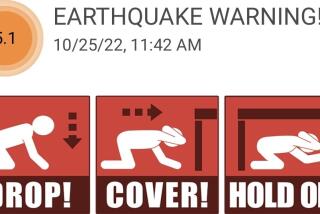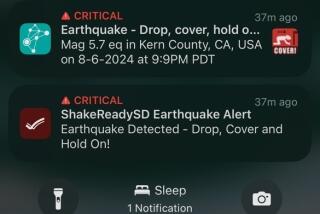Attention Falls on False Alarms From Tsunami Monitors
KOBE, Japan â Hawaii is among the most tsunami-ready places in the world. When an alert is issued, beachside sirens sound and urgent messages flash on television and radio. Evacuation maps on telephone books point people to higher ground.
But most of the time, no damaging tsunami hits the shore.
The Pacific Ocean early warning systemâs high false alarm rate -- estimated at 75% -- is getting more attention these days as experts and nations work to extend similar protection to the Indian Ocean after the tsunami disaster in southern Asia.
âItâs definitely one of our biggest challenges,â said Charles McCreery, director of the Pacific Tsunami Warning System in Honolulu, which sends seismic data and tsunami bulletins to 26 nations around the Pacific. The network was begun in 1965.
In addition to the problem of false alarms, experts say there is a dearth of information on landslides that trigger tsunamis and a wide disparity in the ability of Pacific nations to respond to alerts. Much work remains to upgrade the systemâs technology.
âYou have to take that model and update it,â said Eddie N. Bernard, director of the National Oceanic and Atmospheric Administrationâs Pacific Marine Environmental Laboratory in Seattle.
Accuracy is an important element. Officials say a mega-tsunami in the Pacific wonât be missed by the sensors, and point out that monitors can get seismic information much more quickly than they used to. But the high false alarm rate undermines public confidence and dilutes the effect of alerts. Another issue is money: An unnecessary evacuation in Hawaii in 1994 cost about $30 million in business disruptions and other costs.
Tsunami warnings are compiled using a variety of information. The most immediate data come from seismic readings: Monitors can alert nations within minutes of a large earthquake, and can then update the magnitude from subsequent readings within an hour.
But only a tiny percentage of undersea earthquakes cause dangerous tsunami, meaning subsequent readings from sea level monitors are crucial to forecasting big waves. And that data can take hours to arrive.
A major advance has come with Deep-ocean Assessment and Reporting of Tsunami buoys -- known as DART -- deployed by the United States in the Pacific in October 2002. There are now seven in operation, six operated by the U.S. and one by Chile.
The system consists of an ocean-floor sensor and an acoustic cable linking it to a buoy. The sensor measures any tsunami, and the buoy quickly transmits data to a monitoring station via satellite.
The U.S. has a $37.5-million plan to expand the buoy system to the Atlantic Ocean and Caribbean Sea with new 32 buoys, Bernard said.
Quakes with magnitudes of 9 -- such as the Dec. 26 temblor off Sumatra -- virtually guarantee tsunami. But the ability to predict tsunami from smaller quakes depends on part on the type of tremor, with those that vertically displace water being the most dangerous.
Attention has focused on new technologies that help measure the deformation of the earth along dangerous faults with satellites. Seismologists and others hope someday to use those measurements to monitor the pressure building between plates as a way of predicting when a devastating quake will occur.
Still, educating and preparing local communities to recognize the warning signs and evacuate are essential.
âEducation saves lives,â Bernard said. âNo system is going to get to you in five minutes.â
More to Read
Sign up for Essential California
The most important California stories and recommendations in your inbox every morning.
You may occasionally receive promotional content from the Los Angeles Times.










